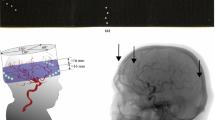Abstract
Preprocessing, binning and dataset subsampling are investigated with regard to simultaneous maximisation of the speed, accuracy and robustness of CT-3D rotational angiography (3DRA) registration. Clinical diagnosis and treatment can both take advantage of this integration, because 3DRA allows the shape of vessel structures to be evaluated three-dimensionally with respect to standard 2D projective angiography. The method for optimising preprocessing, binning and subsampling consisted of independent variation of the corresponding parameters to maximise robustness and speed while maintaining subvoxel accuracy; the latter was computed as the sum of the mean squared errors initially present in the registrations with the errors relative to both binning and subsampling. The results suggest the choice of 256 bins, steps between 14 mm (coarse optimisation) and 2.5 mm (fine optimisation) and bone segmentation by threshold, for binning, subsampling and preprocessing, respectively. The application of this parameter set-up to 50 CT-3DRA registrations resulted in a saving, on average, of 40% of the time with respect to the method previously used, while registration error was maintained within 2 mm (1.97 mm, 90% confidence interval) and robustness was increased, so that no manual initial realignment was needed in 48 registrations. Validation by the registration of images acquired for a head phantom showed subvoxel residual errors. In conclusion, the proposed procedure can be considered a satisfactory strategy to optimise CT-3DRA registration.
Similar content being viewed by others
References
Adler, J. R., Murphy, M. J., Chang, S. D., andHancock, S. L. (1999): ‘Image-guided robotic radiosurgery’,Neurosurgery,44, pp. 1299–1306
Aoki, S., Sasaki, Y., Machida, T., Hayashi, N., Shirouzu, I., Ohkubo, T., Terahara, A., Sasaki, Y., Kawamoto, S., Araki, T., andMaehara, T. (1998): ‘3D-CT angiography of cerebral arteriovenous malformations’,Radiat. Med.,16, pp. 263–271
Bidaut, L. M., Laurent, C., Gailloud, P., Muster, M., Fasel, J. H., Rufenacht, D. A., andTerrier, F. (1998): ‘Second-generation three-dimensional reconstruction for rotational three-dimensional angiography’,Acad. Radiol.,5, pp. 836–849
Colombo, F., Cavedon, C., Francescon, P., Casentini, L., Fornezza, U., Castellan, L., Causin, F., andPerini, S. (2003): ‘Three-dimensional angiography for radiosurgical treatment planning for arteriovenous malformations’,J. Neurosurg.,98, pp. 536–543
De Munck, J. C., Verster, F. C., Dubois, E. A., Habraken, J. B., Boltjes, B., Laus, J. J. andVan Herk, M. (1998): ‘Registration of MR and SPECT without using external fiducial markers’,Phys Med. Biol.,43, pp. 1255–1269
Gallina, P., Merienne, L., Meder, J. F., Schlienger, M., Lefkopoulos, D., andMerland, J. J. (1998): ‘Failure in radiosurgery treatment of cerebral arteriovenous malformations’,Neurosurgery,42, pp. 996–1002
Kakizawa, Y., Nagashima, H., Oya, F., Ito, K., Tanaka, Y., Hongo, K., andKobayashi, S. (2002): ‘Compartments in arteriovenous malformation nidi demonstrated with rotational three-dimensional digital subtraction angiography by using selective microcatheterization. Report of three cases’,J. Neurosurg.,96, pp. 770–774
Kessler, M. L., Pitluck, S., Petti, P., andCastro, J. R. (1991): ‘Integration of multimodality imaging data for radiotherapy treatment planning’,Int. J. Radiat. Oncol. Biol. Phys.,21, pp. 1653–1667
Klabbers, B. M., De Munck, J. C., Slotaman, B. J., Langendij, H. A., De Bree, R., Hoekstra, O. S., Boellar, R., andLammertsma, A. A. (2002): ‘Matching PET and CT scans of the head and neck area: Development of method and validation’,Med. Phys.,29, pp. 2230–2238
Kumazaki, T. (1998): ‘Development of rotational digital angiography and new cone beam 3D image: clinical value in vascular lesions’,Comput. Methods Programs Biomed.,57, pp. 139–142
Maes, F., Collignon, A., Vandermeulen, D., Marchal, G., andSuetens, P. (1997): ‘Multimodality image registration by maximization of mutual information’,IEEE Trans. Med. Imaging.,16, pp. 187–198
Piotin, M., Gailloud, P., Bidaut, L., Mandai, S., Muster, M., Moret, J., andRufenacht, D. A. (2003): ‘CT angiography, MR angiography and rotational digital subtraction angiography for volumetric assessment of intracranial aneurysms. An experimental study’Neuroradiology,45, pp. 404–409
Pluim, J. P. W., Maintz, J. B. A. andViergever, M. A. (2003): ‘Mutual-information-based registration of medical images: a survey’,IEEE Trans. Med. Imaging,8, pp. 986–1004
Stancanello, J., Cavedon, C., Francescon, P., Cerveri, P., Ferrigno, G., Colombo, F., andPerini, S. (2004): ‘Development and validation of a CT — 3D rotational angiography registration method for AVM radiosurgery’,Med. Phys.,31, pp. 1363–1371
Sugahara, T., Korogi, Y., Nakashima, K., Hamatake, S., Honda, S., andTakahashi, M. (2002): ‘Comparison of 2D and 3D digital subtraction angiography in evaluation of intracranial aneurysms’,Am. J. Neuroradiol.,23, pp. 1545–1552
Viola, P. A., andWells, W. M. (1997): ‘Alignment by maximization of mutual information’,Int. J. Comput. Vis.,24, pp. 137–154
Author information
Authors and Affiliations
Corresponding author
Rights and permissions
About this article
Cite this article
Stancanello, J., Cavedon, C., Francescon, P. et al. CT—3D rotational angiography automatic registration: A sensitivity analysis. Med. Biol. Eng. Comput. 43, 667–671 (2005). https://doi.org/10.1007/BF02351041
Received:
Issue Date:
DOI: https://doi.org/10.1007/BF02351041




